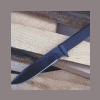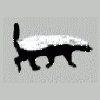
Noz
Napisano Ponad rok temu
Zainteresowanym polecam tez ksiazke Leo Figela "On Damascus steel"
Napisano Ponad rok temu
THE ART OF THE CUTLER
In years past the late Tom Sewell wrote extensively in these
pages about Jean Jacques Perret, the 18th century French master
cutler and surgical instrument maker who was, very likely, the
greatest knifemaker who has ever lived. Perret was the man who,
beginning as a teen-ager, worked in and learned the trade secrets
of every cutlery center in France. Perret was the man who did a
full course of study at medical school, in order to improve the
quality of his surgical instruments. Perret was the man who said
that a practical test of a cutler's skill was for him to draw out
from bar stock a steel wire 6-1/2 inches long and 1/6 inch in
diameter, and then to drill a 1/12 inch diameter hole through
this wire with his breast drill -- the long way. And Perret was
the man who, in 1771, wrote and illustrated what is still the
finest knifemaking how-to book ever published.
Perret's book is called L'Art du Coutelier -- "The Art of
the Cutler". It includes three large thick volumes, the latter
two dealing with surgical instruments, and all three illustrated
with hundreds of splendid engravings.
Every aspect of knifemaking is covered, from engineering
design and materials preparation, to the art of selling and shop
management. Of course some of the material is obsolete, such as
the parts pertaining to pre-Revolutionary French business
practices, although even here we might learn a thing or two.
Most of Perret's technical material, however, is as valid today
as it was when it was published, over 220 years ago.
Today we might use power saws instead of hand saws to cut
ivory, horn, or wood handle slabs, but the principles of sawing
these materials to achieve stable dimensions and attractive grain
have not changed at all. Today we might use refined steel alloys
that Perret never dreamed of, and we might buy ready-made drill
bits and lathe cutters where Perret made his own, but when it
comes to shaping those alloys and using those tools, Perret could
teach most of us a lot more than we could teach him.
I imagine that Perret would be pleased to see the current
popularity of damascus steel in hand-made knives today, both in
America and in his native France. Perret made many damascus
knives and swords, as did other Parisian cutlers both before him
and after him. Some of his contemporaries even made fake
damascus, and Perret exposed their shady methods.
As far as we know, no one in Europe at that time made
eastern damascus, what we now call Wootz. However Perret and his
fellow European cutlers were familiar with that material, and
recognized that it was different from their own product. Perret
called it le Damas naturel "natural damascus." Since we now know
that the pattern in Wootz forms spontaneously, this seems to be a
very appropriate name.
Damascus steel was such a popular topic in Perret's own day
that he felt called upon to include an entire chapter on its
fabrication in The Art of the Cutler. This is Chapter 29,
"Maniere de faire l'Acier facon de Damas" ("Method of making
Steel in the style of Damascus"). Here is a somewhat loose
translation. [Note]
PICTURE 1 [FEATURE THIS: AT LEAST 1/3 PAGE]
CAPTION:
Plate LXIV from L'Art du Coutelier by Jean Jacques Perret.
* * *
MAKING DAMASCUS IN 1771
by Jean Jacques Perret
We might have discussed this steel in the chapter on
materials, because it is one. However, since it is not
appropriate for fine cutting edges, we believed it our duty to
treat it separately, although this steel does serve very well for
making table knives.
This material, which closely imitates "natural" damascus,
can become costly. This is because of the time required [to make
it], as well as because of the quantity of coal one must employ,
and the diminution of the metal [during fabrication]. If one
wishes to make 3 pounds weight, it is necessary to start with 6
pounds weight of raw material.
Start out by forging six thin plates of iron, exactly
identical in all respects. Let us suppose that they are each a
pouce (an inch) wide, a ligne (1/12 inch) thick, and 12 inches
long. Then forge five thin plates of steel, identical in form to
those of iron, making in total eleven thin plates. The more
plates one uses, the finer the material will be. Stack these
plates one atop another, but be sure to put each steel plate
between two of iron, which means starting and finishing with an
iron plate. This is how it must be done, no matter how many
plates one uses. This should become clear from Figure 1.
[In the figure] each thin plate is numbered from 1 to 11,
and under each number one sees a letter that designates the
material: A for Acier (steel) and f for fer (iron).
Once all this is properly arranged, grasp all the plates
with a tongs. Clamp the handles of the tongs with an "S" as
shown in Chapter 12. Place this stack in a moderate fire. Raise
the temperature so that all the plates heat uniformly through and
through, but do not allow any of them to burn. To this end, turn
the packet often in the fire, without removing it, and then let
it rest in the fire a little while. The plates that are in the
center will not heat up as fast as those on the outside, mainly
because the latter receive heat directly from the coals, while
those in the center receive none except from their neighbors.
Finally, when the whole thing is uniformly hot, moderate the
pumping of your bellows, "sand" [i.e. dust with flux] the
material at least twice after each heat, and forge it squarely,
working it down to a thickness of 8 or 9 lignes (2/3 to 3/4 inch)
on a side. After this is done, heat the material up to a bright
red, but not quite white, and clamp one end in the vice, as shown
in Figure 2. With stout tongs twist the material from one end to
the other, as evenly as possible, so that it resembles a screw,
as shown in Figure 3. Now it is necessary to flatten and forge
it out to a width of 9 lignes (3/4 inch) and a thickness of 3
lignes (1/4 inch). After this fold it in two [the long way], in
the manner shown in Figure 4.
All this work, up until now, is for nothing other than to
form a strong tenacious covering, such that no effort or power
can break it apart. The plates of soft iron are thoroughly
welded, married, and entwined with the ones of steel, forming
together an extremely tough material, more tough than either
component. The iron and steel are well bonded together, and the
individual particles of each are very small.
However, it is not possible for this material to be given a
really fine cutting edge. The "veins" of iron that wind
throughout prevent it.
Make, therefore, a thin plate of good German steel 9 lignes
wide, Figure 5, (that is, the same width as the covering), and at
the very most 2-1/2 lignes thick; its length must be equal to
that of the covering which has been folded in half. Put this
steel plate between the two sides of the covering. Then forge
weld the whole assembly. Do not overheat the billet. Avoid
striking it too hard. Use only the face of the hammer. Shape
the surfaces squarely, so that the steel remains always in the
center of the billet, because upon this depends the quality of
the cutting edge. Then draw out the billet to the length and
width which you require.
A blade made from damascus material can never break, save
only by forcefully bending it back and forth many times.
Therefore it makes a strong knife. And if one tempers this knife
to the color of red copper, after having hardened it at a cherry
color, one would be able to cut iron very readily with it,
without the edge chipping, provided however that one made the
edge a bit thick and rounded. But if one is making this knife to
cut food at the table, and one does not wish to show off with it,
one should give it a little finer cutting edge, which requires no
more than tempering it to a gold color, instead of red copper
color. Then one will have a good tool which will cut well, and
which will keep a good edge for a long time.
If men did not seek so often to pinch pennies on that which
is useful, all the while making huge expenditures on useless
ornamentation, then instead of having a sheath knife worn at
one's side whose blade cost not even 40 sols (five-cent pieces),
but whose mounts cost 60 livres (pounds); one might instead have
a blade which cost 60 livres, in mounts which cost 40 sols.
Nothing can make a better blade for a Couteau de chasse
(literally a "hunting knife," but actually a hunting sword, or
hanger) than damascus material just as I have described. Its
utility is found in the implement's requirements [chopping
through bones].
The object for which this material is nearly indispensable
is the Damas a decoler, the damascus beheading sword. Figure 6
represents the one which is used by the Honorable Mr. Sanson.
[Charles Henri Sanson, 1740-1795, was the public executioner in
Paris. He was to preside over the execution of Louis XVI in 1793.]
His sword is 9 inches long in the handle, between A and B,
and 3 feet in the blade (3 French feet, or 39 English inches).
The width is, at the base of the blade, 2-1/2 pouces, tapering
very slightly to C. Its thickness below B is three lignes (1/4
inch), but it thins steadily right up to the point, where it is
but one ligne (1/12 inch) thick at C. This makes it more
flexible than an epee.
It is double-edged and does not have a sharp point. On the
contrary it is well-rounded, because a sharp point can get stuck
in the vertebrae. Being rounded and well polished, it slides and
cuts easily. Its edges are the same on both sides, and it is as
keen as a fine pen knife that is used for sharpening quills. It
is necessary that it be polished the long way on a polishing
wheel which is at least an inch wide, taking careful precautions
not to injure oneself. It must be honed on a razor stone, or
else on a fine-grained Levant stone. This is what I have always
done.
On might well think that forging damascus material and
forging pure steel are much the same thing; in either case one
must treat them with "art" in order to preserve their "virtue."
However, it is necessary to forge damascus with a great deal more
care. Once it is completely welded throughout, it is not
necessary to give it additional welding heats. Most of all, in
the final heats, do not heat it past cherry color, and in the
last heat past the color of bronze. Then hammer the material
well until it is cold. One need not be ashamed to use files to
shape it. File it without additional reheating.
The hardening, which gives the final touch of quality to
this material, must be done with all possible attention. For
such a piece as this, do not use just any forge. Instead light,
on the ground, a charcoal fire of sufficient size to surround and
heat the entire piece. When the fire is burned down to coals,
put the piece in the center and cover it completely with hot
coals.
Do not use a bellows, but only agitate the air with a piece
of cardboard, or something equivalent. Pay attention that the
blade heat uniformly throughout. As soon as it has reached a
bright cherry color, plunge it into a big bucket of water, or a
big cask of water if the hunting sword or saber is three feet
long.
Some people brag about certain other hardening methods
which, if truth be told, do not have anything wrong with them.
However, since we discussed this subject elsewhere, I will not
say any more about it here. I will merely point out that with
proper attention paid to forging the steel, and to the degree of
heat in the hardening, plain cold water is worth more than all
the ingredients which one might add to contaminate it.
When damascus is polished, the eye of the connoisseur can
judge if it is really damascus, because one can distinguish the
flowing whitish veins of the iron from the bluish veins of the
steel. However, for giving effective color to damascus, and to
make those veins stand out, pour a little eau forte [dilute
nitric acid] on to the piece (completely finished). Spread it
out over the entire length of the blade with a feather. Leave
the acid on the blade for the space of 6 or 7 minutes. After
this time rinse the blade with clear water, dry it, and you will
find it damassee, which is to say one may readily distinguish the
veins of steel from those of iron.
In general, steel is subject to having closely spaced veins.
[This is a feature of shear steel, the best type available in
18th century France.] In consequence one can be fooled, and buy
steel blades which are not damascus, because it is only necessary
to wipe a knife, a razor, &c, with some acid, to give it the
color of damascus. However, one can judge [real damascus] by the
regularity of the "flowers," and by the veins of iron which flow
with a sort of regular symmetry. On can also recognize damascus
steel, worked the way we have described, by its being largely
forged to shape, and because its veins are small and evenly
distributed, and because the metal is of good quality.
I have seen some hunting swords which were sold as damascus,
but which I suspected not to be, in part because the blackish
veins were too deep, and in part because their edges would not
cut iron. Indeed their edges were so blunt and ill-shaped that
they would not even cut wood.
I tried to discover the method of "damascening" blades as
boldly as these. After several trials I took a blade of polished
steel and I covered it with a coating of wax, which I let drip
from a lighted candle. I spread the wax evenly over the entire
surface. Then I drew a quantity of lines in the wax, using a
steel scribe which served me as a pencil. After that I poured
some acid on the wax. I allowed it to bite or dissolve the steel
which my "pencil" had uncovered for about an hour. I then
cleaned it off, and found that I had discovered the whole
secret.
Napisano Ponad rok temu
To najlepsze co mogę polecić do walki po robocie nie żal wyrzucić, a i zakup jest łatwy i można psom powiedzieć spadaj, jak cie zaczepią.
Napisano Ponad rok temu
To najlepsze co mogę polecić do walki po robocie nie żal wyrzucić, a i zakup jest łatwy i można psom powiedzieć spadaj, jak cie zaczepią.
Chcesz zaczepiajace cie psy traktowac rzeznickim nozem? Sam spadaj stad pojebie jeden bo ciebie takim nozem potraktuje. I sie pospiesz do psychiatryka albo od razu sie poloz na tory bo szkoda ze takie scierwo jak ty po swiecie lazi.
Napisano Ponad rok temu
Napisano Ponad rok temu
Napisano Ponad rok temu
Wosiu, Nikt miał zapewne na myśli Policję - Psy... I rzeczywiście gdyby się czepiały do noszenie przez ciebie noża kuchennego to można im powiedzieć "spadaj"...
Jesli tak to co innego, ale nazywanie policjantow na publicznym forum per "psy" tez nie jest zbyt eleganckie. Mozna tym na przyklad obrazic niektorych kolegow z forum czy cos...
Napisano Ponad rok temu
Zabic mozna widelcem , srubokretem mozna tez nozem kuchennym ale nie jest to tematem przewodnim tego , publicznego przeciez forum.
Polecam wiec tego typu stwierdzenia ( powtarzajace sie zreszta) wypisywac na licznych ztronach typu food.tv czy warmachine
[/b]
Napisano Ponad rok temu
Napisano Ponad rok temu
Naprawdę fachowców nie jest tak dużo, przeciętny przestęcpa coś tam umie, co podpatrzył od kumpli, gówniarze przepraszam młodzież, napatrzyła się na filmach i szpanuje. Nóż jest naprawdę niebezpiecznym narzędziem. Groźnym i niestety zabójczym i to niezależnie od tego czy jest w rękach zawodowca czy laika. Jeśli nas zaskoczy to po zawodach jesli nie możemy próbować walczyć. Czy ma nóż kucheny czy kupiony firmowy nie ma znaczenia. Jeśli mówimy o nożach firmowych to raczej w kategoriach kolekcjonerskich, najczęściej są uzywane noże kuchenne, są łatwiej dostępne. Jeśli chodzi o używanie pewnych słów slangowych to proponuje niektórym do uczyć się niż obrażać innych. Każdy ma prawo do swojego zdania, a obrażanie ludzi nie jest tu na miejscu. Gdybyśmy się spotkali i rozmawiali bezpośredniop, kolega nie użyły zapewne tych słów, których użył, chyba, że one określają jego osobowość.
Policjanci często nie reagują na określenie psy, nie dlatego że je lubią, ale dlatego że wolą mieć święty spokój, niż użerać się z typkiem który na nich wrzeszczy. Sam byłem światkiem zdarzenia, jak jeden glina udzielił rady swojemu koledze jak ma potraktować wezwany patrol. Kolega odszedł na bok, a patrol po przyjeździe stiwerdził, że niepotrzebnie ich wezwano, że sprawa jest błacha i na następny raz pani która ich wezwała zapłaci karę za nie uzasadnione wezwanie. A facio który rozrabiał, tak na nich wyzywał, że gdyby trafił na mnie , to przez miesiąc przeklinałby dzień w którym otworzył usta. Wiem jak takiemu smykowi umilić życie zgodnie z prawem. Ale gliny wolą mieć święty spokój. Ja jestem już cywil, ale gliną jest mój brat i szwagier, to też wiem co nieco na ten temat.
Napisano Ponad rok temu
Napisano Ponad rok temu
I dlatego mają tak zafajdaną reputację. Jak mu się nie chce ruszyć d... we własnej sprawie, to pewnie wolą mieć też mieć święty spokój jak za rogiem kogoś kroją.Policjanci często nie reagują na określenie psy, nie dlatego że je lubią, ale dlatego że wolą mieć święty spokój, niż użerać się z typkiem który na nich wrzeszczy.
Napisano Ponad rok temu
Po co taki Nikt wogole zostaje czlonkiem forum budo?!
W kazdym z dzialow mozna wyskoczyc z propozycja zamiany treningu czegostam na noz kuchenny.... I w sumie tu i owdzie miec racje ale chyba nie o to chodzi??
Napisano Ponad rok temu
Statystycznie rzecz ujmówjąc najwięcej zabójstw jest popełnianych za pomoca noża kuchennego. Ci co pracują w policji coś o tym wiedzą. A określenie psy jest dość popularne na tym forum.
Zęby zakończyć ten temat, chodzi mi o to, że najczęściej na ulicy spotkam gówniarza z nożem kuchennym lub 10 calowym gwoździem niż z markowym nożem, jego nie stać na taki wydatek. I pytanie do fachowców wiecie jak się przed tym bronić?
Jak gnojek wyciągnął balisonga i spytał się czy ładny ( a był to jakiś tandetny model 10 cm ostrza ) a ja wyciągnąłem KS i spytałem się czy mój mu się podoba, to gnojek spierniczył. Na szczęscie dla mnie, gdyby zaatakówął byłoby nie wesoło ( nie ważne czy bym ja go pociła czy on mnie I tak trzeba by się tłumaczyć "panom" policjantom dlaczego tam byłem ( Kolo własnego garażu ) itd. . Jakby na to nie patrzeć to źle.
Napisano Ponad rok temu
Napisano Ponad rok temu
I statystycznie rzecz biorąc to babki kasują swego konkubenta podczas libacji lub wymuszonych "amorów" a akcja dzieje się w czterech ścianach.Statystycznie rzecz ujmówjąc najwięcej zabójstw jest popełnianych za pomoca noża kuchennego. Ci co pracują w policji coś o tym wiedzą. A określenie psy jest dość popularne na tym forum.
Nie mój cyrk, nie moje małpy. Boisz się, że będziesz z taką jadł kolację
Określenia "psy" nadużywa młódź, odreagowywując jakieś tam zaszłości. Eleganckim się ono przez to nie staje.
Zęby zakończyć ten temat, chodzi mi o to, że najczęściej na ulicy spotkam gówniarza z nożem kuchennym lub 10 calowym gwoździem niż z markowym nożem, jego nie stać na taki wydatek. I pytanie do fachowców wiecie jak się przed tym bronić?
A co to za pytanie
Natomiast nie jest mi obojętne co ja wyciągam. Bo jeśli od tego zależy mój los, to nie chcę obciąć sobie palców z powodu kiepskiej blokady, czy zostać z niezablokowanym ostrzem, bo miałem okruszki w kieszeni.
Dlatego mówi się tu o dobrych markowych kosach. Pewnie, że temat fascynujący i chwilami robi się z tego licytacja :roll:
Napisano Ponad rok temu
Kolekcjonowanie nozy jest pieknym hobby, podobnie jak strzelanie. Ale nie przeklada sie ono na walke. Czyli to, ze mamy 50 nozy, czy trafiamy w 10 powiedzmy 8 razy na 10, nie oznacza wcale, ze w razie zagrozenia sie obronimy.
A co do uzywania slangu, fakt, ze policja nie reaguje na obrazliwe wyzwiska, nie oznacza, ze zwalnia mnie to z zachowania pewnego poziomu kultury.
Wojtek
Napisano Ponad rok temu
Co do noza to jeszcze raz powtarzam ludzie na Budo nie szukaja najskuteczniejszego narzedzia zeby kogos zabic , nie beda tez nosili przy sobie kilku nozy kuchennych zeby po zarznieciu goscia , wyrzucic je od smieci.Jak najbardziej sie z toba zgadzam ze noz kuchenny to najpopularniejsz bron przy morderstwach ( poszukaj mojego posta mowiacego o statystykach , uzycia tej broni).
JEdnak mysla przewodnia tego forum sa SZTUKI WALKI , a nie bezszelesetne podrzynanie gardel.Tak samo sie bronisz przed nozem do oierania ziemniakow , jak i przed microtechem , ale juz wole sie broni maja MAd Doga niz noz do warzyw , ty nie to twoja sprawa , chodz z kompletem "Henkell" za paskiem.
Napisano Ponad rok temu
Statystycznie rzecz ujmówjąc najwięcej zabójstw jest popełnianych za pomoca noża kuchennego
na ulicy spotkam gówniarza z nożem kuchennym lub 10 calowym gwoździem niż z markowym nożem, jego nie stać na taki wydatek.
Hmm... To mi nie wygląda na dowód na to, że do skutecznej walki nóż kuchenny sprawdza sie równie dobrze jak rasowy fighter, ale raczej na to że nasze społeczeństwo jest biedne... Z tym drugim nie mam sie jak nie zgodzić...
--------------------------------------------------------
A propos domowo-nożowych kłótni i świadomości czym jest nóż... Przypomniał mi się post z zamieszczonymi różnymi zdjęciami obrażeń wynikłych z bójek ( z tego co pamiętam to tylko domowych ) z nożem w ręku... Był baaardzo sugestywny.
Nie mogłem go jednak znaleźć, a myślę, że każdy powinien go obejrzeć...
Tu propozycja dla moderatorów... Może powinien być obowiązkąwym postem widocznym zawsze obok ustawy o broni i amunicji?
Napisano Ponad rok temu
Może to taki odpowiednik "Waszych" gówniarzy...?
Co jak co, ale chyba nikt z ludzi których tak się nazywa nie chodzi za koniem z wiadrem i nie zbiera jego odchodów... Rozumiem też że Wy nie biegacie po trawnikach obwąchując rzeczone drobiazgi...
Można usprawiedliwiać się, że określenie 'gówniarz' zaryło się już w naszej kulturze zmieniając troszkę znaczenie... No cóż... wygląda na to że podobnie jest z psami...
Użytkownicy przeglądający ten temat: 2
0 użytkowników, 2 gości, 0 anonimowych
 FaceBook
FaceBook
10 następnych tematów
-
 Pierwsze noże
Pierwsze noże- Ponad rok temu
-
 Pytanie do PiteraM i innych fachowców
Pytanie do PiteraM i innych fachowców- Ponad rok temu
-
 Kershaw Vapor
Kershaw Vapor- Ponad rok temu
-
 odetne sobie palce ... czy tez nie ?
odetne sobie palce ... czy tez nie ?- Ponad rok temu
-
 Nauka walki nożem
Nauka walki nożem- Ponad rok temu
-
 Timberline Zambezi
Timberline Zambezi- Ponad rok temu
-
 Konkurs "nożowy" :)
Konkurs "nożowy" :)- Ponad rok temu
-
 Nowy ksztalt ostrzy w customach
Nowy ksztalt ostrzy w customach- Ponad rok temu
-
 Zabawki dla duzych chlopcow - ver. custom
Zabawki dla duzych chlopcow - ver. custom- Ponad rok temu
-
 a co powiecie na to? (niby comander za 12$)
a co powiecie na to? (niby comander za 12$)- Ponad rok temu








